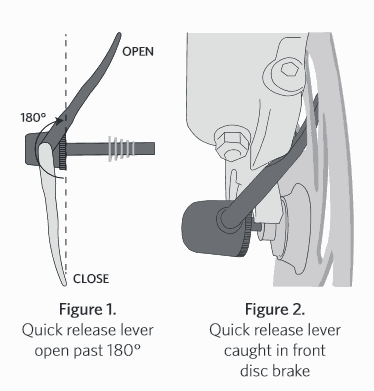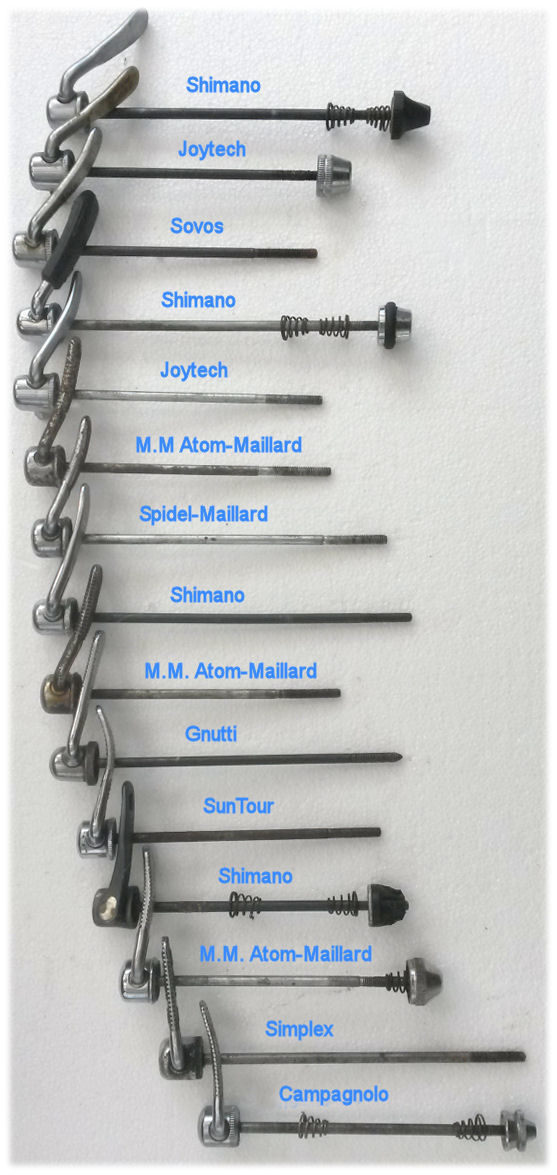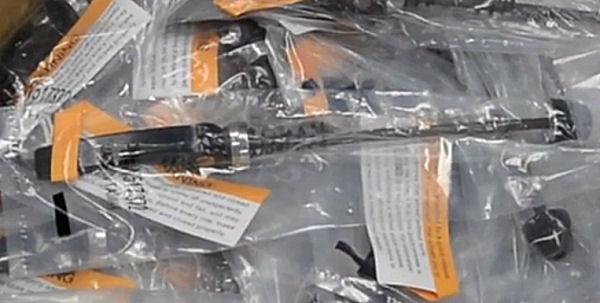
|

![]()
Trek Bicycles has recently (late April, 2015) announced a recall of nearly 1,000,000 front-wheel quick-release assemblies because the lever (handle) could open far enough to catch in a disk brake rotor. Probably, the wheel would either jam or come off. Injuries have been reported including one cyclist who was rendered quadriplegic.
The drawing below from the Trek recall notice illustrates the problem.

![]()
![]()
The problem has been identified, and so the next question is "now, could you please identify the culprit?"
The photo below shows 15 quick-release assemblies from our rather diverse collection. Each is opened as far as it will go. The assemblies are arranged in order of how far they open, from most to least. The brand of each skewer is labeled.

![]()
![]()
What does the lineup show?
Granted, these are not all brands and models of quick releases. There are many others, and as the quick-release is a small component, it may not carry any identification beyond the name of the company which manufactured or outsourced it. We can't pin down the year when each of these assemblies was made, though we can identify some of them as old because they are rusty, or the manufacturer is no longer in business or making quick-releases (Simplex, Maillard, Gnutti, SunTour) or the lever is straight rather than curved, as required by the US Consumer Product Safety Commission beginning in 1978.
The lineup does show that the problem occurs with only some of the newer quick-release assemblies, and none of the older ones.
The opening-too-far problem occurs with three common brands found in our collection: Shimano, Sovos and Joytech. It occurs with only one of our four Shimano examples and one of our two Joytech examples.
None of our examples are external-cam quick-releases. We couldn't test any because we haven't collected any. There are other good reasons to avoid them. Also see our article about quick releases.
There are several ways that a quick-release can become loose, due to misalignment or misadjustment. Maybe it was never clamped down correctly at all. (Read here about how to install one correctly.) Also, as James Annan has described, use of a front disk brake can loosen the quick-release.
Road vibration could easily open the quick-release lever once it is loose, and then it could tangle in the disk-brake rotor..
![]()
![]()
That the problem existed for nearly 15 years and occurred with only some examples of the same brands suggests strongly that nobody at Trek had identified it and was testing for it.
The problem certainly isn't limited to Trek bicycles, as the same brands and models of components are found on many brands of bicycles. On the other hand, it is probable that not all the bicycles subject to recall have this problem, because of the inconsistencies within each brand of quick releases.
I find it perplexing that Trek highlighted the problem of the quick release's opening too far when there is another, related problem, that the disk brake exerts a force which can loosen the quick release, even if it was properly adjusted when installed.
I find it even more perplexing that Trek is offering external-cam replacement quick releases, less secure than the traditional enclosed-cam quick releases. The still image below is from a USA Today video in which a Trek dealer explains the recall.

Not only are these quick releases less secure, they are very fiddly to install and remove. They have washers which need to be held in position by hand on both sides of the wheel at the same time. [I assumed that the external-cam quick releases with washers in Trek's installation video were the same as those in the image above, but taking a second look through the cloudy plastic packaging, I found no washers. See comment in the Postscript section of this article.] Compare Trek's video showing installation of a quick release with washers (the external-cam quick release) with Trek's video showing installation of a traditional enclosed-cam quick release. Installation and removal of a wheel with a traditional quick release on a bicycle without "lawyer lip" secondary retention devices is easier and much faster yet, as shown in our own video -- though less foolproof.
With a loose lever, the "lawyer lips" which were probably present on most if not all of the affected bicycles would keep the wheel from falling out of the frame when the front wheel rises off the ground, though it would be wobbly. A cyclist sensitive to the "feel" of the bicycle would stop on noticing this problem, but if the quick-release lever flipped open and caught in the brake disk, a crash could occur before the cyclist took action. Also, once the quick release was loose, only the thin skewer would retain the wheel against the disk brake's force trying to eject the wheel. Simply applying the front disk brake might bend the skewer or break it off.
Notice also that the spiraling arms of the rotor in Trek's drawing are oriented to pull the quick-release lever in. The rotor could also be installed with the other side facing out, and then the arms would would tend to push the lever out. The brake would work just the same. I have seen real bicycles with the rotor oriented to pull the lever in.
Inc. Magazine describes the Trek recall as a case study in good crisis response. I disagree. That conclusion may seem to make sense from a business perspective, but Inc. evidently lacked the expertise to address the technical issues.
Ideally, we would want bicycles which are properly assembled, adjusted and maintained to be free of problems which lead to sudden, catastrophic, unexpected failure. Any mechanical system will deteriorate sooner or later, and so an incipient failure should preferably give warning in advance, or be preceded by another, more benign failure which puts the part out of service, or be so very unlikely that it is not of serious concern, or a second system should be able to take over from one which failed. A properly-adjusted enclosed-cam quick release assembly on a bicycle with no front disk brake meets this test, by being very unlikely to fail.
Beyond this, we would want user error also not to lead to hazardous outcomes, to the degree this is practical. That is the concept behind the various secondary retention devices which are intended to keep a front wheel from falling out if the quick release is loose -- or to reduce the liability exposure of the manufacturer. (The most effective of these devices, which secures the wheel even if the skewer breaks, is no longer being manufactured.)
![]()
![]()
How do we look at the probability of failure, and its costs? Malcolm Gladwell addresses these issues in the New Yorker magazine of May 4, 2015 (pages 46 and following), pointing out that perfection is never achieved, and that emotion and media attention may skew public perceptions and regulatory action. The famous Ford Pinto with the exploding gas tank, Gladwell points out, was no less safe, all in all, than other cars of the same general type, and the gas tank design was not unusual. Gas tank rupture accounted for only a small percentage of all casualties, but the spectacular failure mode led to heightened media attention and strong reactions from media and government. The more recent issue with ignition switches on General Motors cars similarly has claimed only a small number of victims, but the finger points more decidedly at the manufacturer. This was an easily curable problem, known to the manufacturer and which dragged on for years.
Every gasoline-powered car must have a gas tank, and unavoidably, some kind of crash will rupture it. The car will also have an ignition switch, but the hazard of the GM switch is unnecessary. The problems with bicycle quick releases and disk brakes have, like those problems, carried on for a long time, but they are more like the one with the ignition switch -- easily avoidable and inexpensive to solve, if solved before a product goes to market.
In the long run, I think that bicycle manufacturers need to get together and establish a laboratory where samples of products are stress-tested and fatigue-tested to failure, and where combinations of components are assembled while asking the question "what could go wrong, if..." One tactic in computer-software testing is to input odd combinations of data into a program to try to break it -- and then to repair the program to trap incorrect input. The same kind of test is appropriate for mechanical systems.
Shimano is renowned for its product engineering, though maybe not as good on testing established designs for compatibility. Schwinn had a laboratory, decades ago, and it was common to see the label "Schwinn-Approved" on outsourced components. These parts often had Schwinn-specific improvements not found on their manufacturers' generic versions. The Japanese bicycle industry established the J.I.S. (Japanese Industrial Standard), which played an important role in bringing Japanese bicycle products up to world-class quality. But such efforts do not go far enough in the bicycle industry. There are many different combinations of parts from different sources which can go together to make a bicycle, and some will be dangerously incompatible with others. There's a real need to test, just as with the software.
Someone really should have been looking out for what might happen with the combination of a disk brake and a quick release. It isn't, as the saying goes, rocket science.
A few additional points have come up since I took the article public.
Additional observations are welcome!
![]()
![]()
Last Updated: by John Allen